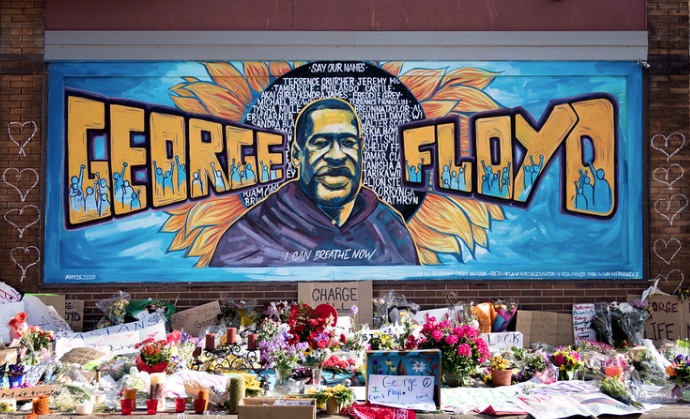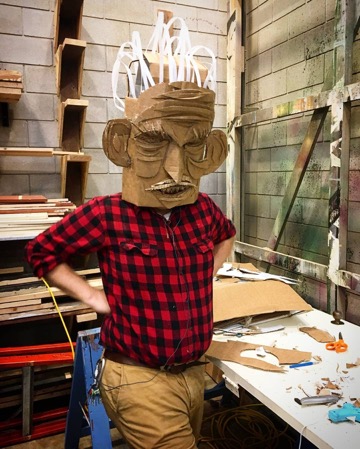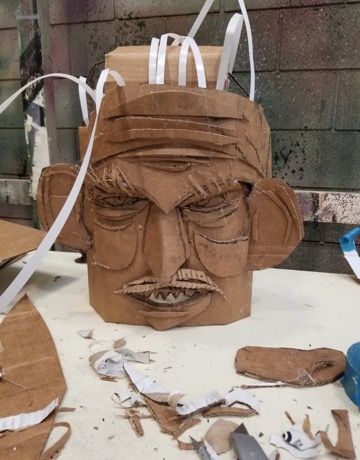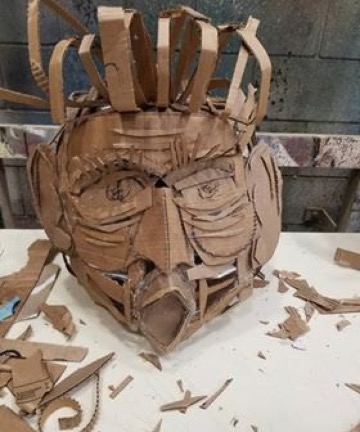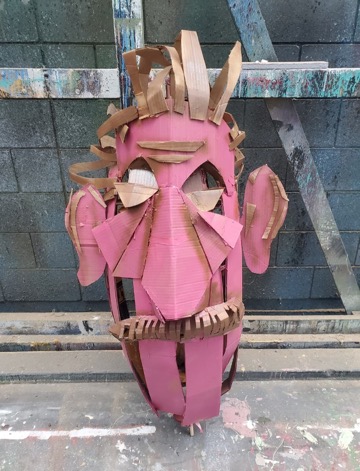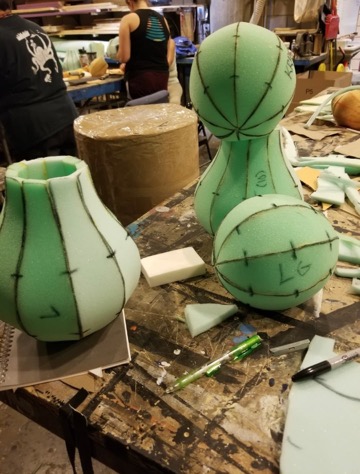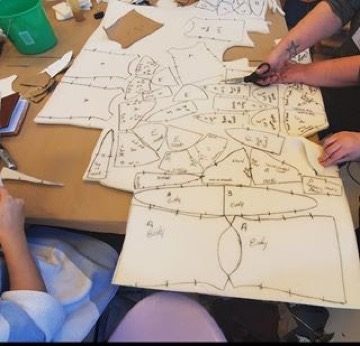A Brief Visit Into Puppetry
by Lucas Granholm
The 2018-19 theatre season at The University of Minnesota Morris included a production of The Wonderful Wizard of OZ by Jaqueline E. Lawton. The script itself shares a lot of similarities to the original texts by L. Frank Baum and is written in such a manner that the designers are afforded a great deal of wiggle room. As always when producing any version of OZ the design team is presented with a great deal of iconic moments that demand a degree of spectacle.
Looking over the script I discovered that a great deal of the design challenges presented could be accomplished through puppetry. A Lighting Designer by training, I had little experience with puppetry beyond the occasional shadow puppet, so I sat down at a computer and did what any common millennial would do and “Googled it”.
As a designer does with any new artform, there is a great deal of research and play that needs to occur prior to application in the artform. The photos and captions below showcase short snippets that occurred over the course of this year researching and playing.
Below is a list of artists and companies that I looked at during this process...
Wayne White
Kara Walker
Dan Hurlin
Bread and Puppet Theatre
In The Heart of The Beast
Open Eye Figure Theatre
Manual Cinema
The Time For Play
Below are images of finished and half finished pieces I experimented with to become familiar with that process of puppetry and mask making.
Explorations in Cardboard
The images below are masks I created out of old cardboard. The hair is accomplished with old packing strips. This method works great for masks and small puppets. I found this method very satisfying in regards to construction as you needed so little to create dynamic looking faces.
Shadow Puppetry
Shadow puppets afford you the opportunity to utilize the screen projected on almost like a film (Soft focus, playing with perspectives, fade-ins and outs to name a few). This was perhaps the most exciting element of puppetry that I worked with due to the massive amount of variations a designer can take when playing with light and shadow.
While experi-menting with various shadow puppet constructions, I found custom cut puppets were not time effective. The image to the right is of shark shadow puppets made from a Cricut cutter. This allowed for a variety of replacement parts to be created quickly and consistently.
Here is our Frog Shadow puppet. This is an example of a one handed puppet with a hinged jaw. Puppets of this nature are easily made but do not withstand a great deal of wear and tear.
Foam Patterning
Learning the process of foam patterning can be quite fun if you love drafting or draping. Materials for this require a bit more specialization as well as safety equipment as many of the glues used for foam construction can be toxic if inhaled. ALWAYS READ THE LABELS!
The images above and below show the process of foam patterning for Muppet style puppets. This method also correlates well with prop making.
Application to The Wonderful Wizard of Oz
Below are production photos wherein this research was incorporated into the production. Foam patterning did not make its way into the performance but has been very useful for a variety of props in recent years.
The Wonderful Wizard of Oz
By Jacqueline E. Lawton
Directed by Ray Schultz and Zoe Swigerd
Stage Manager Wendy Unger
Scenic Design by Alyssa Olsen and Lucas Granholm
Lighting Design by Lucas Granholm
Costume Design by Katie Curry
Sound Design by Evan Aanerud and Lucas Granholm
Puppetry Design by Alyssa Kraft and Lucas Granholm
Technical Direction by Benjamin Fink
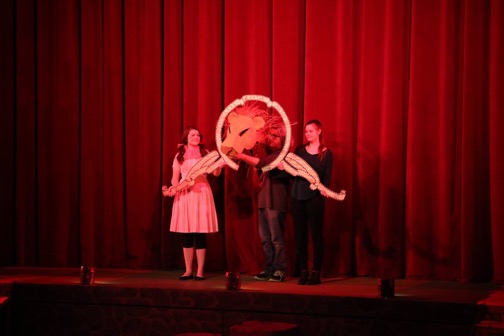 The MGM Lion
The MGM Lion
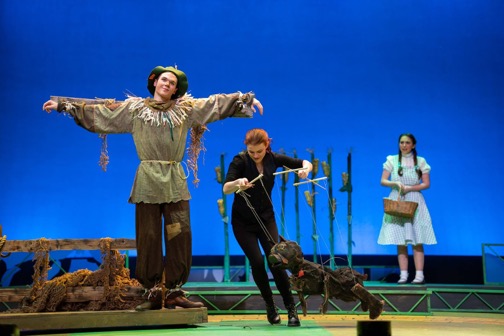
The Toto Puppet
Knowing full well that this puppet would be onstage just as often as Dorothy and needed to be able to dance alongside Dorothy and the Scarecrow, I knew a marionette would work best for this puppet. To begin this design I employed basket material to create the body of Toto. I found that this was the strongest and lightest option.
Shadow puppetry
Walking around my Scene Shop I stumbled across my now rarely used overhead projector. Inspired by the work of the Manual Cinema Theatre I started to explore various ways to accomplish the various design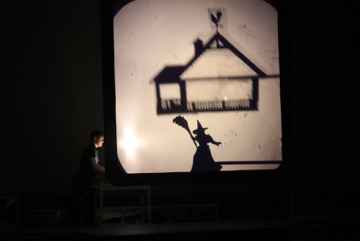 challenges the script presents such as the Wicked Witch melting, flying monkeys, the great and powerful oz, and of course the tornado sequence. All the shadow puppets used in this production were done with one overhead projector.
challenges the script presents such as the Wicked Witch melting, flying monkeys, the great and powerful oz, and of course the tornado sequence. All the shadow puppets used in this production were done with one overhead projector.
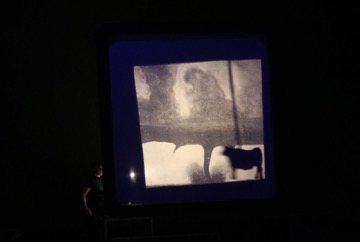 At left is the tornado sequence. The overhead projector allowed the puppeteer to create depth in the shadows by moving the figures closer or further away from the lens creating a dissolve (such as this cow).
At left is the tornado sequence. The overhead projector allowed the puppeteer to create depth in the shadows by moving the figures closer or further away from the lens creating a dissolve (such as this cow).
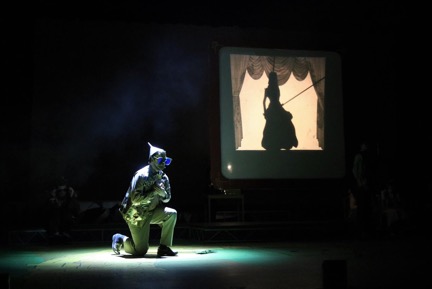
Shown above is the Tin Man and the Great and Powerful Oz. For this scene we utilized a standard stick and rod puppet.
Below is the Scarecrow and the Great and Powerful Oz. In order to emulate fire onstage we utilized what is often referred to as a "Liquid Light Show". This method is created by mixing baby oil, water and food coloring on a glass plate. The operator moves the liquid to create a surreal effect.
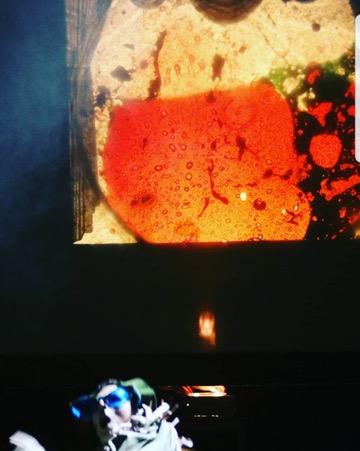
The Flying Monkeys were a constant recurring effect in the show. We were able to accomplish this through the layering of shadow puppets and real actors as shown below.
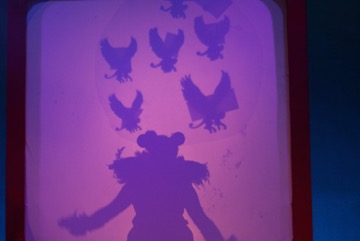
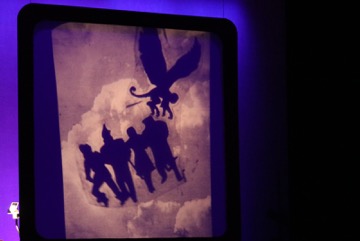
For additional viewing of all the puppet moments in the production, use the Youtube link below:
https://www.youtube.com/watch?v=khKb3y066zY [ ]
Lucas Granholm is an Assistant Professor in the Theatre Department at University of Minnesota, Morris.

